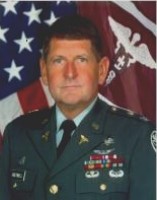

DDS, Medical College of Virginia
BS, Florida State Univ.
diplomate, Federal Services Board of General Dentistry
diplomate, American Board of General Dentistry
master, Academy of General Dentistry
fellow, International College of Dentists
fellow, Pierre Fauchard Academy
fellow, Academy of Dentistry International
National Trustee for Federal Dental Services, Region 17, Academy of General Dentistry
Dean/Commandant, Academy of Health Sciences, Ft. Sam Houston, TX, 2003 to present
In the fall of 1996, the U.S. Army Dental Corps was faced with reduced dental officer strength and an expanding mission of dental readiness and oral wellness. To address these growing concerns, a “Hit Team” was established by the Dental Corps Chief to develop a Concept and Feasibility Plan outlining better business practices to improve clinical efficiencies within the U.S. Army Dental Corps.
The original “Hit Team” had 10 members. It was no accident that 5 of the 10 were graduates of the U.S. Army-Baylor University Graduate Program in Health Care Administration. The Baylor-trained individuals were vital to the vigorous process required to create architecture to analyze key processes, develop metrics, and outline efforts leading to improved operational performance outcomes. In essence, they were the driving force in the development of a new model for the delivery of dental care in the U.S. Army.
The Concept and Feasibility Plan was briefed to the Dental Corps Chief and Board of Directors in Feb 97. After acceptance by the Board and Corps Chief as the new direction for Army Dentistry, follow on briefs were given to TSG and OSD (HA) in Mar 97. Working with the U.S. Army Dental Command (DENCOM), the “Hit Team” conducted several potential Beta site visits and the new model was officially named the “Dental Care Reengineering Initiative (DCRI)” in May 97. The Baylor trained dental officers completed a Business Plan, followed by a Campaign Plan, in Jun 97. An Implementation Team and Oversight Committee were established in Aug 97 to field DCRI. Both the Team and Committee were lead by dental officers who were Baylor HCA graduates. The Dental Corps Chief described DCRI as a watershed event in the history of The Dental Corps. As DCRI progressed at the Beta sites, an aggressive marketing strategy was employed throughout the DENCOM and AMEDD Oct 97-Jun 99. In Jul 98, the Oversight Committee merged with the Implementation Team and the DENCOM conducted a worldwide Clinic Management Conference in Sep 98 to outline the new direction for Army dentistry. The Implementation Team, lead by a Baylor alumnus Dental officer, continued to field DCRI throughout the DENCOM.
In Jul 99, a report with recommendations on the continued implementation of DCRI was merged with the DENCOM to become the standard operational model for The Army Dental Care System. That report was compiled by a Baylor graduate dental officer. Since Jul 99, when the DENCOM became the proponent for DCRI, much progress has been made. Following a Strategic Planning Conference in Aug 00, the initiative was renamed “The Dental Care Optimization (DCO) Program,” reflective of TSG’s focus on health care optimization. The DENCOM provided model guidelines for DCO clinics and solicited dental activities to develop business plans for participation of individual clinics. These business plans were reviewed and approved for funding by DENCOM. As DCO expanded throughout the DENCOM and metrics were validated and improved, the business plan sought venture capital funding to further expand and sustain DCO. In Jul 03, a DENCOM team, lead by a Baylor Graduate Dental Officer, submitted a business case to train Expanded Function Dental Assistants (EFDA) as an integral part of DCO. U.S Army Medical Command Venture Capital funding was realized for FY 03-05 and POM funding scheduled FY 06-09. These Venture Capital monies, some $5 million over FY03, FY04, and FY05, will be used to enhance dental readiness, fitness, and productivity and to transition DCO to the POM years. In FY 06, the EFDA POM is $7.5M, in FY 07 - $8.1M, in FY 08 - $8.7M, and $8.9M in FY 09.
Dental officer graduates of the Baylor program contributing to this effort that I am aware of: Mary C. Concillo, Priscilla H. Hamilton, Karl K. Harris, Ronald J. Hayes, Ronald J. Lambert, W. John Luciano, Francis E. Nasser, Jr., Jimmie C. Schmidt, Joseph A. Wineman. The leading roles and efforts of these individuals shaped the resounding success of DCRI/DCO and revalidated the need to have dental officers trained in Health Care Administration. Thanks to these individuals and to all the dental officers, NCOs, and civilians who contributed to establishing a new, improved, and lasting legacy for the Army Dental Care System.
It is no easy task to change the culture, business practices, and operational performance of a worldwide organization such as the DENCOM. With the leadership of the key individuals listed above, an irreversible change was accomplished within the Army Dental Care System in 6 years. A remarkable success story!
2. After Action Report - Dental Corps Hit Team Expanded Board of Directors Meeting; 20-22 Feb 97; COL Darwin Fretwell.
3. Dental Care Re-engineering Initiative - Final Performance Report. Summary of the Implementation Phase; 30 Jun 99; COL Francis E. Nasser, Jr.
4. Dental Care Re-engineering Initiative - Case Study of Strategic Management and Business Process Re-engineering in the U.S. Army Dental Corps; 26 Feb 01. COL’s Francis E. Nasser, Jr. and Joseph P. Connor.
5. DCO Implementation. Correspondence with COL W. John Luciano, Assistant Chief of Staff for Strategic Initiatives, U.S. Army DENCOM.